Evidence Summary and Approach
Active travel means travelling by walking, wheelchair or cycling. This page lays out the vision, priorities and targets for East Dunbartonshire’s new Active Travel Strategy 2023-2030 and four project themes that new active travel projects will deliver. The contents of the new strategy are based on a review of national, regional and local policy, consultation with the people of East Dunbartonshire and a comprehensive assessment of East Dunbartonshire’s existing active travel assets.
What are the aims of recent national and regional active travel policies?
[See Evidence Report A for more detail]
National active travel policy has progressed significantly since East Dunbartonshire’s first Active Travel Strategy was published in 2015. Current policy focuses on achieving net zero by 2045, reducing car dependency, creating 20-minute neighbourhoods and promoting active travel through segregated cycling infrastructure.
Regional transport policy (SPT’s draft Regional Transport Strategy) has adopted national aims to reduce car kilometres and transport emissions while setting the additional target that 45% of journeys should be made by modes of transport other than private cars by 2030.
National
Route map to 20% reduction in car Km by 2030: a clear national target for modal shift away from the car.
National Planning Framework 4: Local living in 20-minute neighbourhoods, people are connected to services, amenities, leisure and work by a 10 minute walk (approx. 800m) or a short cycle. The policy relies on access to active travel infrastructure that gives people the option to replace short car journeys with active travel.
Net zero target: Scotland to reach net zero emissions of greenhouse gases by 2045, with interim targets of 75% by 2030 and 90% by 2040.
Active Scotland Delivery Plan: aims to reduce obesity and increase activity in Scotland in line with national targets.
Active Travel Framework: by 2030, Scotland’s communities are shaped around people and place, enabling walking and cycling to be the most popular mode of travel for short, everyday journeys.
Strategic Transport Projects Review 2: sets out what 20-minute neighbourhoods will look like: a reallocation of road space for pedestrians and cyclists, network improvements (including surfaces, crossings, lighting), segregated cycling infrastructure on important urban routes and long-distance routes connecting villages to key amenities and transport.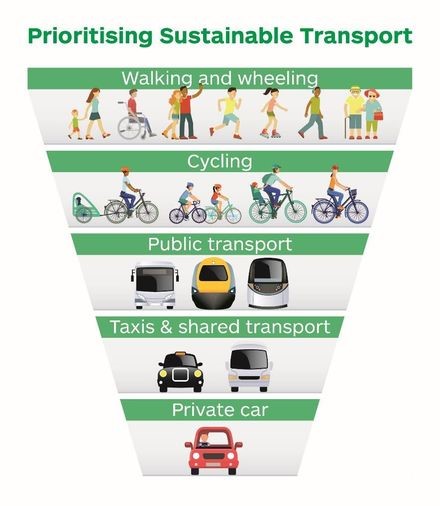
The Transport (Scotland) Act, passed in October 2019, bans pavement parking, double parking and parking at dropped kerbs. A suite of secondary legislation is required to bring this legislation into force, giving local authorities the tools to enforce the ban on inconsiderate, obstructive parking.
Regional
Regional Transport Strategy targets:
- 20% reduction in car Km by 2030
- 56% reduction in transport emissions by 2030
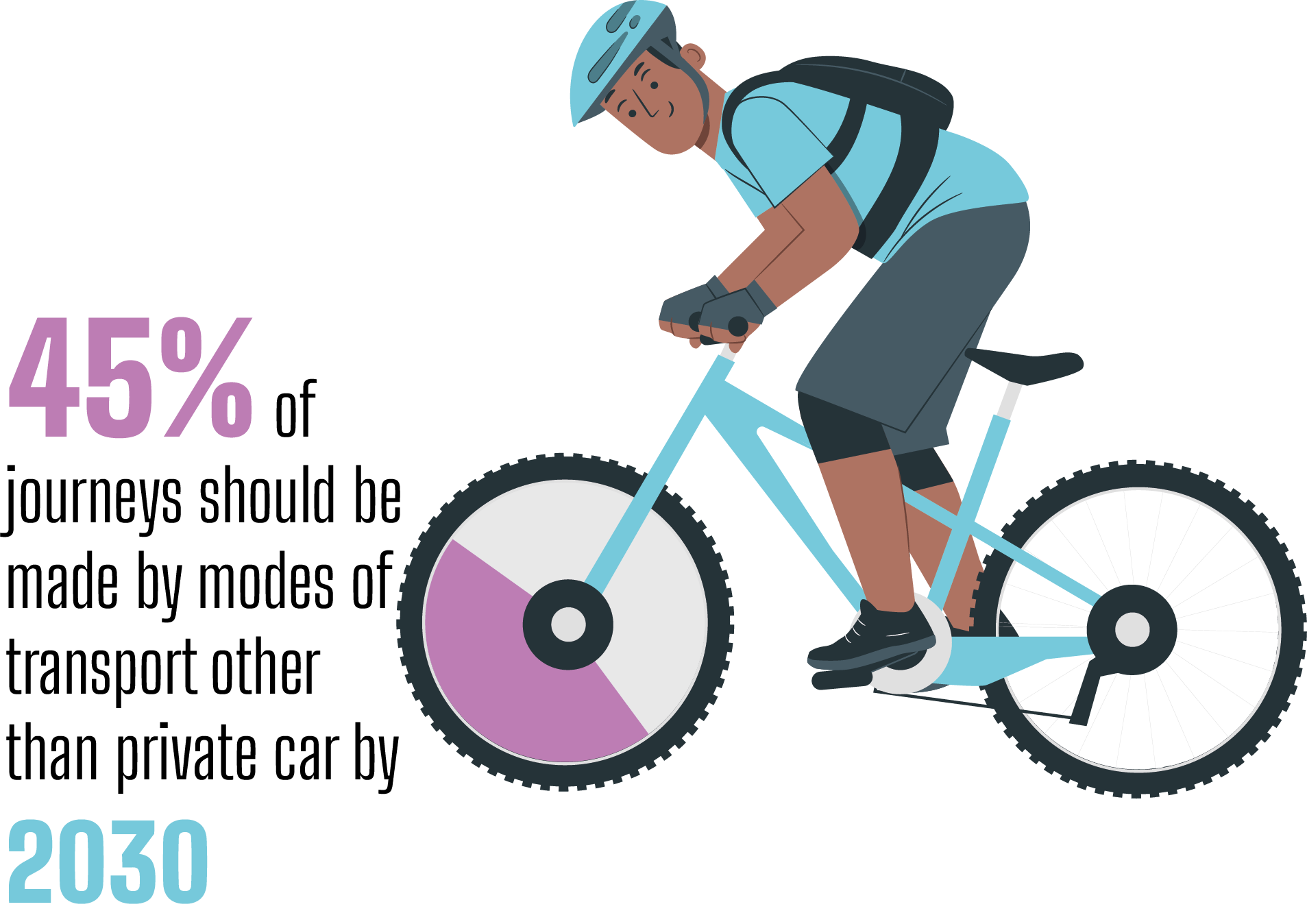
Scotland’s second National Transport Strategy (2020) embeds the sustainable travel hierarchy in transport decision-making and investment.
The case for active travel based on evidence, data and the network audit/network connectivity assessment
[See Evidence Reports A, B and C for more detail]
Active travel can bring benefits to individuals, communities and society. The following data and research present a compelling case for urgent action in developing networks of active travel infrastructure that provide everyone with opportunities to switch short, everyday journeys to active travel.
Physical and mental health
- There are links between adult obesity levels and travel behaviour: countries with higher levels of active travel generally have lower obesity rates
- Regular bike commuting is linked to lower risks of cancer and heart disease
- Physical inactivity costs the NHS up to £1 billion each year
- One in six people experience depression, anxiety or stress-related problems – evidence suggests active travel can contribute positively towards mental health
Climate emergency
 Modal shift, in this case switching journeys from the private car to other forms of transport, is essential if we want to reduce emissions, make a positive contribution to global efforts to curb the impacts of climate change and achieve net zero by 2045.
Modal shift, in this case switching journeys from the private car to other forms of transport, is essential if we want to reduce emissions, make a positive contribution to global efforts to curb the impacts of climate change and achieve net zero by 2045.
- In Scotland, transport accounts for 37% of total emissions
- 40% of transport emissions are from private cars
- Two-thirds of car journeys are single-person occupancy and 45% of journeys are under 5km
Infrastructure and participation
If you build it, they will come: where there is more infrastructure for active travel (i.e. cycleways safely separated from the road), there are higher rates of active travel.
- In the Netherlands, where active travel infrastructure is comprehensive, 30% of all journeys under 5 miles are cycled and 36% list the bicycle as their most frequent way of travelling
- In Seville, Spain, where extensive cycling infrastructure has been constructed recently, rates of cycling have skyrocketed, with an 11-fold increase in the number of cycling journeys following the creation of a comprehensive, 120km network of cycling infrastructure
What about Scotland?
- 2% of women and 8% of men cycle as their most frequent way of travelling
- 58% of women and 49% of men fail to meet physical activity recommendations
- In East Dunbartonshire, rates of car ownership are higher than the Scottish average and modal share for active travel (particularly cycling) is low
But it’s not all doom and gloom. In 2020, mainly due to lockdown measures, active travel modal share increased significantly showing significant potential for future change.
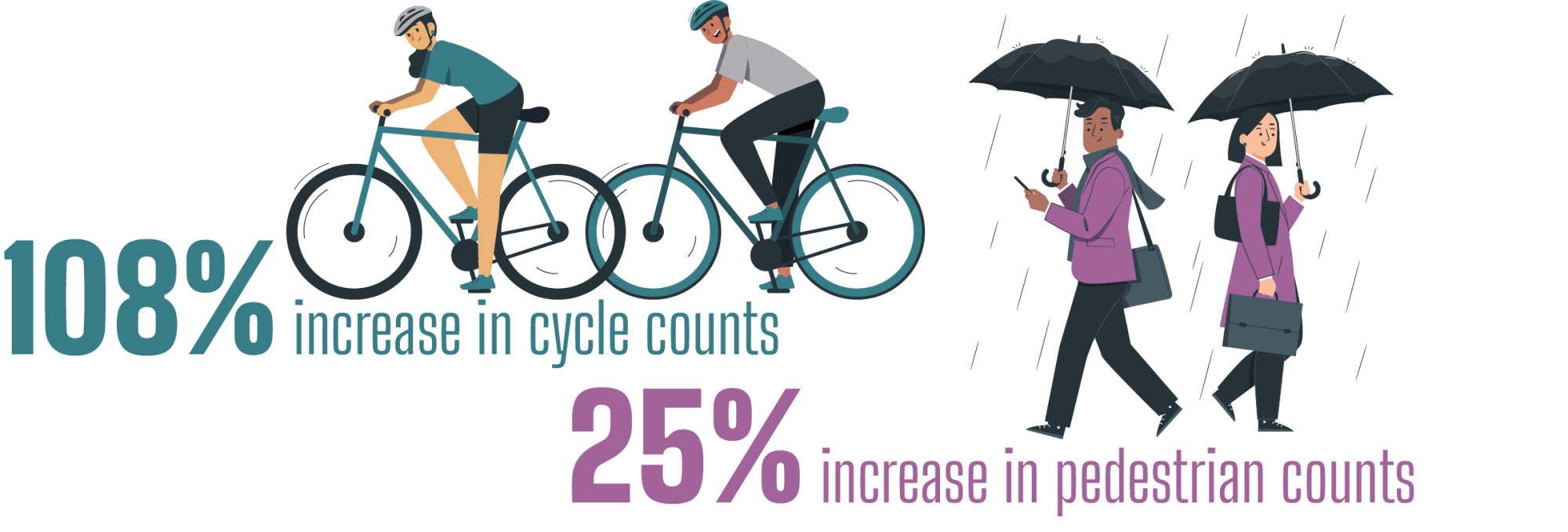
And even those who do not use active travel infrastructure will feel the benefits through:
- Safer streets with reduced vehicle traffic
- Improved air quality
- Reduced congestion as journeys are switched from private cars to active travel
Network audit
The network audit (Report B) was completed by Council officers in 2021 and 2022. It shed light on some of the strengths, weaknesses and opportunities for active travel in the area.
|
Strengths |
Weaknesses |
Opportunities |
|
|
|
The network audit approach was focused on off-road paths whereas often, for active travel, the most well-used and direct paths are roads and footways themselves. The network audit did not assess the active travel amenity on roads and footways.
Network connectivity assessment
The network connectivity assessment (Report C) looked at how East Dunbartonshire’s active travel network connects people and the places they want to go for everyday journeys. The map below is a cropped version of the map of Milngavie that appears in the report. Schools, shops, supermarkets, public transport, health centres, leisure centres, greenspaces and active travel routes are marked. As mentioned above, the marked active travel routes are off-road and some users can be put off by poorly lit paths which tend to be less direct than on-road alternatives.

The assessment found gaps in the current network in all towns with notable gaps between East Dunbartonshire’s locality areas and local amenities (Hillhead and Harestanes, Twechar, Lennoxtown and Auchinairn). Improved connections here would help tackle economic and health inequalities. The assessment also found that active travel infrastructure could be improved around schools and town centres to encourage short, everyday journeys to be taken by active travel.
What have the people of East Dunbartonshire told us they would like the new Active Travel Strategy to achieve?
[See Reports E, F, G and H for more detail]
As part of summer 2021’s active travel discussion an interactive ideas map let residents submit ideas for and make comments about active travel in their area:
- 27% of ideas related to walking
- 20% of ideas related to on-road cycling infrastructure (e.g. extending Bearsway to Milngavie)
- 16% of ideas related to traffic-calming measures and vehicle speeds
- Four times more ideas were received concerning everyday journeys than leisure/exercise
The results sent a clear message that East Dunbartonshire residents desire a new Active Travel Strategy that has a balanced approach to walking and wheeling (travelling by wheelchair), cycling, reduces car dependency in towns and villages and focuses on encouraging active travel for short, everyday journeys.
Parents, staff and students were asked about travel habits and barriers to active travel in the schools survey (part of the active travel discussion):
|
Who? |
How do they get to school? |
What encourages active travel? |
What is a barrier against active travel? |
|
Early years parents |
Mostly walk (over half of 181 respondents) |
Safe routes and crossings |
Traffic and parking problems |
|
Teachers |
|
Bike storage, safe crossings and routes |
Traffic and parking problems |
|
Primary pupils |
Mostly walk (301 of 541 respondents) |
Proximity to school, travelling with family, getting help to cross roads |
Difficulty crossing roads |
|
Secondary pupils |
Over half of 120 respondents walk or cycle |
Nice places to walk and cycle, travelling with family |
|
|
Parents |
A majority walk to school (1066 of 1643) |
Wide-ranging benefits (health, environmental), safe routes and crossing points |
Traffic volumes, parking problems, lack of safe routes and crossing points |
The East Dunbartonshire Travel Survey clearly illustrates an opportunity for increasing active travel in the area. Active travel is perceived as an option by more people than the number of people who actually use active travel to get around for their everyday journeys. The survey identifies the main barriers to active travel:
- Safety
- Convenience
- Carrying things
The Scottish Household Survey found that East Dunbartonshire residents, on the whole, either practice sport or walk for pleasure/everyday journeys weekly. Furthermore, 70% of residents agree climate change is an urgent problem and two-thirds believe their actions and behaviour contribute to climate change. Residents’ habits and views indicate preferences for physical exercise, leisure and climate action, this can be achieved if infrastructure enables more everyday journeys to be taken by active travel.
The Hands Up for Scotland School Travel Survey provides modal share data for school travel in East Dunbartonshire between 2012 and 2021:
- Walking and cycling increased marginally (to 45% and 2.5% respectively)
- Car decreased by 3% to 23%
This data shows an increased desire to travel actively. These trends may be compounded by the current cost of living crisis, leading people to be more conscious of transport choices.
What are the opportunities for active travel based on resident views?
|
Opportunities |
|
Support received in ideas map and surveys for safer streets which encourage active travel, traffic calming and vehicle speed reduction particularly in residential areas and around schools |
|
Support received in ideas map and surveys for on-road, segregated cycling infrastructure that provides separation and protection from traffic, enabling people of all ages and abilities to cycle |
|
Support received in ideas map and surveys for improved walking and wheeling (wheelchair) infrastructure. Opportunities arising from more people walking and wheeling short journeys include: better air quality, safer streets and improved public health |
|
Opportunity arising from high levels of public concern for impacts and urgency of climate change. People mostly understand how individual actions contribute to climate change and, as a result, there is potential for short, everyday journeys switching to active travel |
It is important to recognise the challenges and concerns which were raised in the active travel discussion, such as increased congestion, access for emergency services and reduced parking. Such issues will be considered in the production of the new Active Travel Strategy.
The new Active Travel Strategy and its central vision, to maximise active travel opportunities for those who are able, do not intend to overhaul all streets in East Dunbartonshire. At the heart of the strategy is the simple aim to provide a safe, pleasant experience for active travel.
Equalities
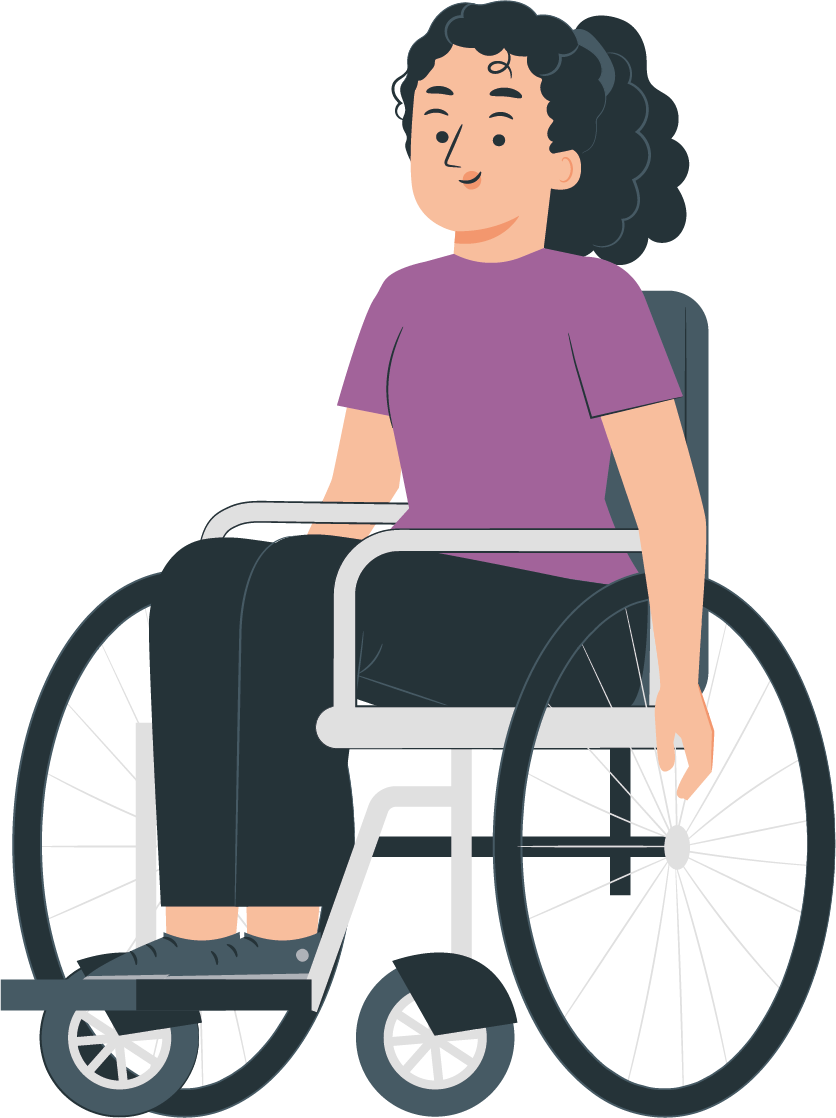 Active travel, where it is safe and accessible, can be a liberating way to experience one’s local area. For a very low cost, people can access the places they want to and enjoy a wide range of benefits.
Active travel, where it is safe and accessible, can be a liberating way to experience one’s local area. For a very low cost, people can access the places they want to and enjoy a wide range of benefits.
This section acknowledges that not everyone can choose active travel as their main way of getting around. As outlined in “the case for active travel” section above, higher rates of active travel create safer, more pleasant towns and villages for everyone.
Equalities groups will have the opportunity to be involved in producing and delivering the new Active Travel Strategy. These processes will ensure that infrastructure and policies consider accessibility for a range of users with various equipment, wheelchairs and cycles. Another priority is ensuring everyone, especially children, can access cycles.
Local transport policy must consider those who do not have access to cars and, as a result, should ensure there are opportunities to access everyday places by other modes of transport.
The new Active Travel Strategy acknowledges the reality of East Dunbartonshire’s varied, and often rural, geography. Rather than attempting to eliminate car use, the vision states active travel should be a natural choice for short, everyday journeys.
What should the new Active Travel Strategy achieve overall?
This SWOT analysis brings together key findings from the evidence reports (report referenced in brackets following each point)
|
Strengths
|
Weaknesses
|
|
Opportunities
|
Threats
|
The following vision is proposed for the new Active Travel Strategy:
Walking, wheeling or cycling will be the natural choice for short, everyday journeys for those who are able
While all policies and actions in the new Active Travel Strategy will help achieve this vision, there are various transport planning objectives and priorities for active travel that the new Active Travel Strategy must consider. The table on the next page shows these objectives, priorities and sets out targets for the new Active Travel Strategy.
|
Local Transport Strategy Transport Planning Objectives |
Priorities for Active Travel
|
Targets |
|
Increase modal shift towards more sustainable modes of travel for both travel to work/study and leisure trips |
1. Provide safe and easy access to everyday places 2. Improve integration between active travel and public transport |
|
|
Reduce inequality by providing high-quality access for all |
3. Empower and encourage all groups of people to walk, cycle and wheel more
|
|
|
Reduce emissions through reduced vehicle mileage in East Dunbartonshire |
4. Improve active travel opportunities to and through areas where air quality issues may pose risks to the public and, in particular, children (e.g. schools, town centres) |
|
|
Facilitate sustainable economic growth by improving connections across our boundaries and between our communities |
5. Make East Dunbartonshire an attractive place for active travel to generate more sustainable business for the local economy |
|
|
Improve health by increasing walking and cycling rates
|
6. Improve physical health, mental health and overall well-being by providing better opportunities for walking, cycling and wheeling for leisure and exercise purposes, including enhanced access to areas of green space |
|
|
Improve safety on all modes of transport
|
7. Ensure vulnerable road users, including those walking, cycling and wheeling, are safe on East Dunbartonshire’s road network 8. Ensure surfaces are of a high standard so appropriate paths and routes can be safely accessed and enjoyed by all |
|
To deliver on the vision, priorities and targets for the new Active Travel Strategy, policies and actions will be organised into four project themes. These themes reflect national and regional active travel policy, recurring themes arising from consultation with East Dunbartonshire residents and the evidence set out in evidence reports. [accordion collapsed]
Theme 1 - A walking and wheeling network
Using roadside footways and off-road active travel paths, an accessible network for walking and wheeling (travelling by wheelchair) will be mapped. Where there are gaps in the network or the network does not meet standards of accessibility, it should be upgraded and completed.
A high-quality, accessible network, it will include features such as:
- Good quality surfaces
- Minimum width
- Safe crossings
- Dropped curbs
An important part of mapping the network will be working with residents and groups to ensure the network goes where people want to go and that it is accessible for all.
Like Pontevedra, the network will be mapped in a way that everyone understands how far and how long they need to walk and wheel their everyday trips.
Why is this necessary?
Infrastructure for walking and wheeling were the most commonly submitted ideas and comments to the ideas map in the active travel discussion. Walking and wheeling can be done by all regardless of age and ability and regular walking and wheeling fulfils recommended physical activity targets.
It is necessary to map and complete a walking and wheeling network so everyone understands how to make short, everyday trips by active travel. This network will make walking and wheeling more attractive options and increase the number of people who walk for everyday trips.
Case Study 1: Pontevedra, a small regional town in northern Spain
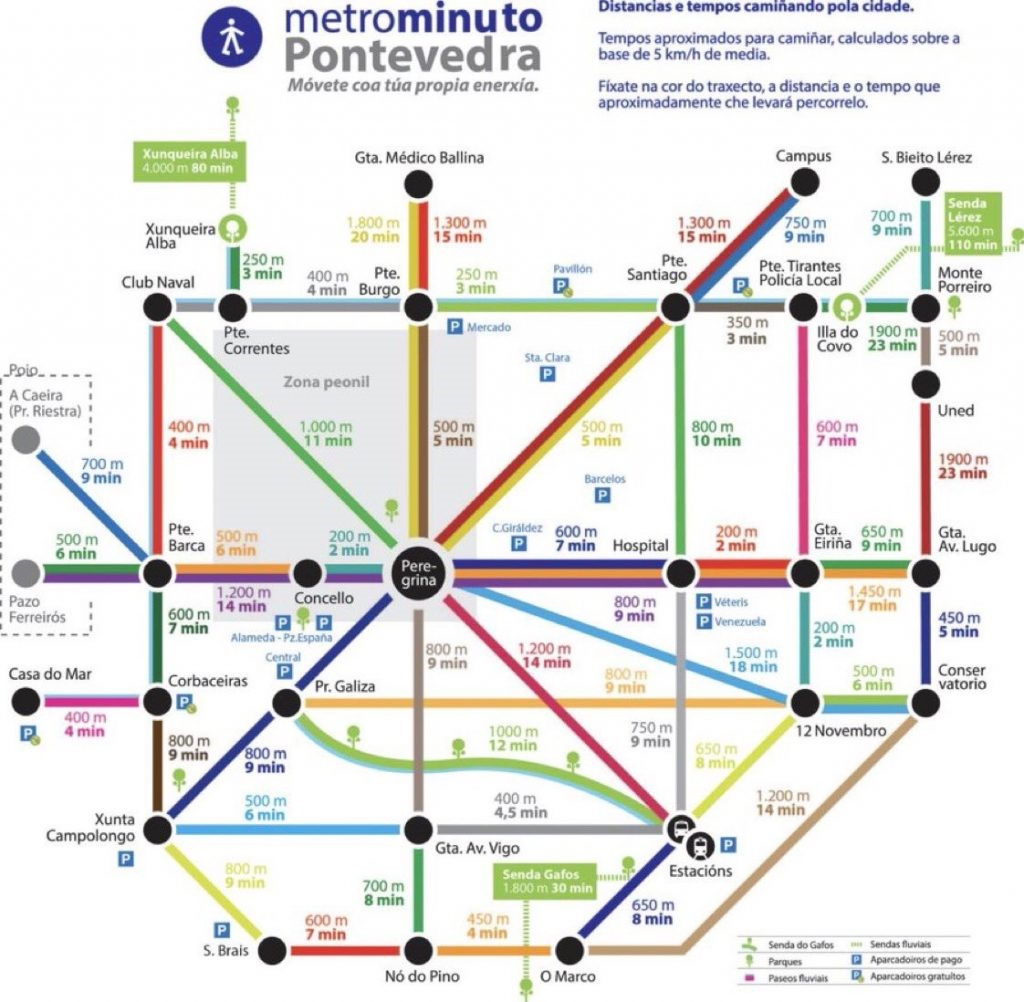
To encourage walking and wheeling as the natural choice for short, everyday journeys, Pontevedra produced this map which is easy to read, recognisable and visible throughout the town.
The map visualises walking and wheeling routes that connect the places where people most want to go on a daily basis.
More than just a map, Pontevedra has an excellent quality, highly accessible walking and wheeling network, with good surfaces, wide pavements and safe crossings that prioritise the movement of people rather than cars. The quality of the walking and wheeling network, combined with the easy-to-understand map makes the area perfect for walking and wheeling short everyday trips.
What about East Dunbartonshire?
Mapping for walking and wheeling networks in East Dunbartonshire will produce a similarly easy-to-digest and recognisable map for each town. This mapping will involve residents, groups and school children. These maps will allow everyone to understand how they can easily walk or wheel pleasant, short everyday trips. Actions in the new Active Travel Strategy will also set out projects needed to improve the quality of the network to a high standard.
Theme 2 - Active travel neighbourhoods
To encourage modal shift to active travel, local streets need to be safer and more pleasant for active travel. A simple way to do this is limiting the traffic that cuts through residential areas. Infrastructure that helps this may include:
- Traffic calming
- Bollards (modal filters)
- Green active travel infrastructure (parklets, trees)
- Speed restrictions
- One way streets
This infrastructure, combined with the proposed national rollout of 20mph zones, will enable people to consider active travel as a safe, realistic option for everyday trips.
This infrastructure can be flexible, moved and temporary. Residents will have significant input throughout the process to imagine safer, more pleasant local streets.
Why is this necessary?
Active travel neighbourhoods will reduce traffic in residential areas and increase the safety and convenience of active travel. Safety and convenience, significantly, are the two main barriers to increase participation in active travel according to local surveys.
There is extensive data from similar schemes showing that measures that restrict traffic on residential streets help to create safer, more pleasant streets that are more attractive for active travel.
Case Study 2: Outer boroughs of London (Newham, Waltham Forest and Haringey among others)
Some suburban, outer boroughs of London have made residential streets safer for active travel by introducing measures to restrict rat-running. These measures include speed limits, one-way streets and traffic-calming infrastructure.
There is significant data on the work of various London boroughs in reducing car traffic in residential areas:
- 47.5% reduction in traffic
- 97.5% increase in cycling rate
- Reduction in rates of crime
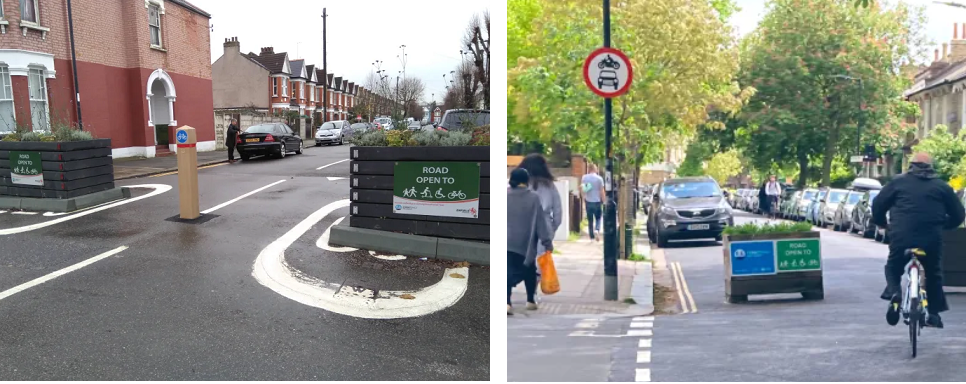
What about East Dunbartonshire?
Currently, East Dunbartonshire has many opportunities for avoiding main roads, taking shortcuts and rat-running through residential areas. The aim is not to close residential streets but make sure they are reserved for residential traffic and active travel.
Schemes are relatively cheap to implement, impermanent and a great opportunity to involve residents in shaping their own neighbourhoods
Theme 3 - Connectivity corridors
Safe, segregated, on-road cycling infrastructure that connects places people want to go. Connectivity corridors will be identified where possible along main routes to ensure safe, direct infrastructure. These corridors would complete gaps in the network between active travel neighbourhoods and the everyday places where people want to go.
Why is this necessary?
Compared to other parts of Scotland and Europe, East Dunbartonshire has low rates of cycling. Infrastructure that makes active travel safe and pleasant by providing protection from traffic is a measure that has been proven to increase cycling’s modal share, safety and attractiveness.
National and regional policy states that networks of segregated cycling infrastructure on key roads should be provided to encourage active travel as the natural choice for everyday journeys and to reduce car kilometres.
Consultation has recorded support for segregated, on-road cycling infrastructure in East Dunbartonshire.
Glasgow City Council is undertaking a programme of cycling infrastructure network building which extends to the borders with East Dunbartonshire. This is a great opportunity for better active travel connections to west, north and central Glasgow from East Dunbartonshire.
Case Study 3: Glasgow, Scotland
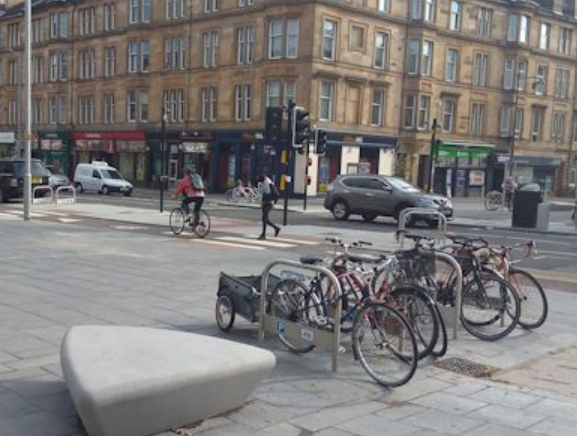 In February 2022 Glasgow City Council approved an active travel strategy that makes walking, wheeling and cycling the first and natural choice for everyday journeys. This will be achieved through the creation of a vast network of segregated cycleways.
In February 2022 Glasgow City Council approved an active travel strategy that makes walking, wheeling and cycling the first and natural choice for everyday journeys. This will be achieved through the creation of a vast network of segregated cycleways.
The Glasgow Active Travel Strategy frames constructing a comprehensive network of segregated cycleways as essential and urgent due to:
- Climate change and environment: shifting the 50% of short journeys under 3km that take place by car to active travel
- Health and wellbeing
- Inclusion and equality
- Wealth and inclusive growth: benefits of active travel for local economies are wide-ranging, including greater consumer spend, job creation and saving travel time
One business made the move to Glasgow’s Victoria Road and reported benefits from the increased footfall and improved access that the South City Way provides.
What about East Dunbartonshire?
East Dunbartonshire can learn from the scale and ambition of Glasgow City’s approach to active travel. Glasgow’s segregated cycling network will stretch to the East Dunbartonshire border. This is an opportunity to ensure those cycleways continue into East Dunbartonshire and connect to the places people want to go for their everyday journeys.
A network of connectivity corridors that provide infrastructure safe enough to encourage current non-cyclists to consider the mode is important to encourage active travel so more people can enjoy the benefits.
Theme 4 - Behaviour change
Behaviour change programmes include activities for groups, schools and businesses (e.g. classes teaching people to ride a bike), organised activities (e.g. led walks/rides) and community-focused resources for all things active travel (e.g. a community hub where bikes can be repaired or people can attend classes on how to maintain their bike).
Why is this necessary?
To shift everyday journeys from the car to active travel, people must have the skills, knowledge, equipment and confidence to do so. Behaviour change initiatives, whether one-off events or long-running programmes, teach people new skills and consolidate existing ones. Such programmes are essential to ensure East Dunbartonshire is a welcoming place for active travel as modal share increases.
Case study 4: Bikeability, Scotland
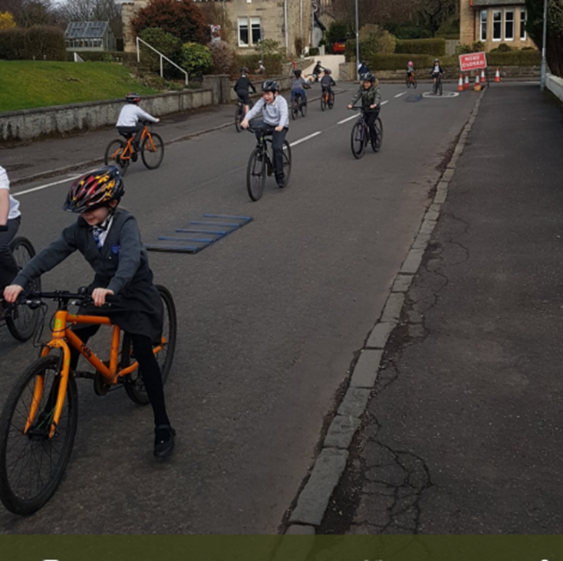 Just like learning to swim, learning to ride a bike safely and confidently is an essential life skill. Bikeability Scotland run cycle training courses in every Scottish local authority, ensuring that the next generation has the skills and confidence to ride safely.
Just like learning to swim, learning to ride a bike safely and confidently is an essential life skill. Bikeability Scotland run cycle training courses in every Scottish local authority, ensuring that the next generation has the skills and confidence to ride safely.
Programmes like Bikeability are essential for creating a culture where active travel can become the natural choice for making short, everyday journeys.
What about East Dunbartonshire?
93.9% of primary schools participate in the Bikeability scheme and there are currently 17 cycle-friendly schools reaching over 5,000 pupils. The first Active Travel Strategy delivered expansion of this scheme as well as the healthy habits programme which provides maps and signs of various parts of East Dunbartonshire